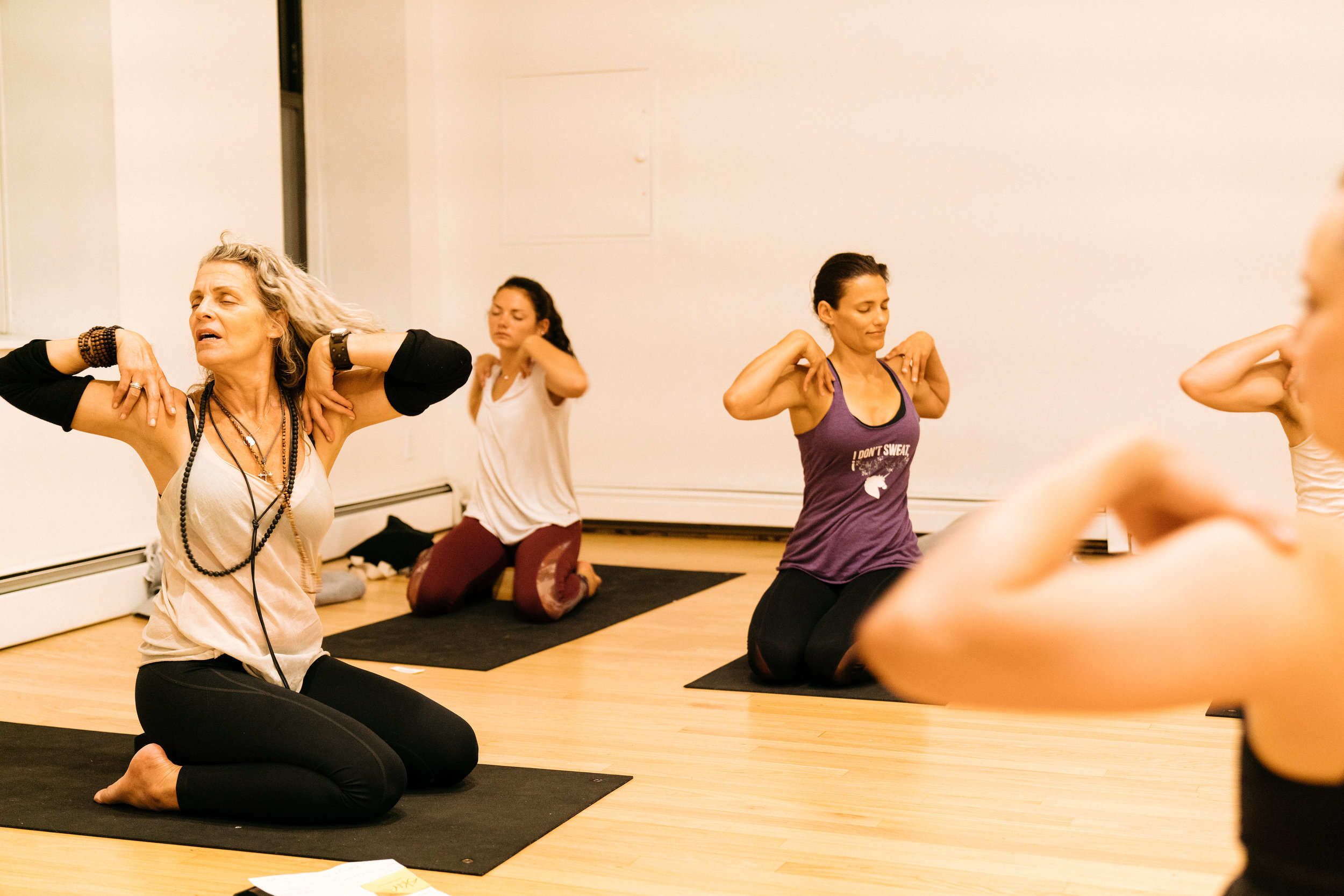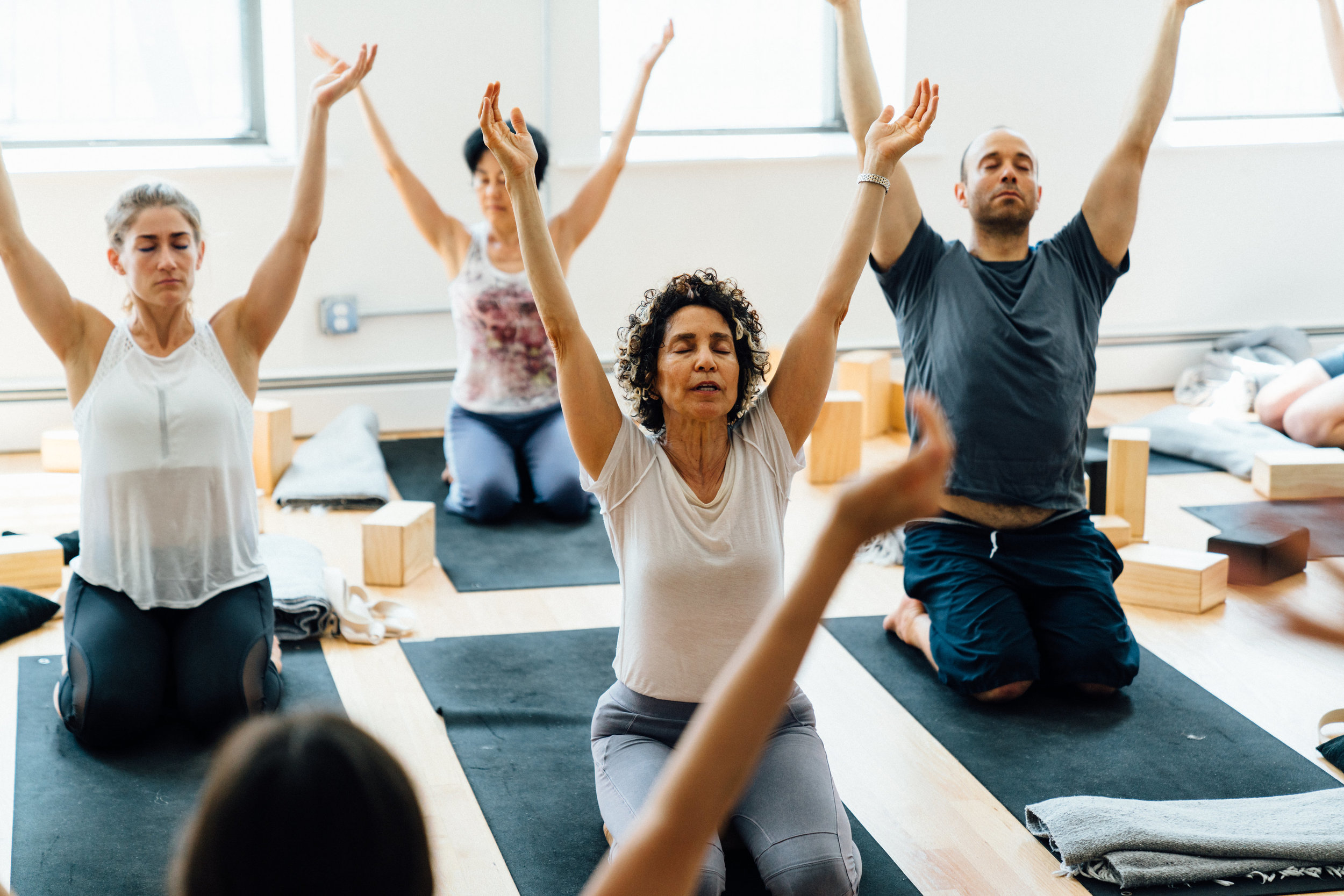A BREATHING PRACTICE
by Abbie Galvin & Nevine Michaan
August 6th 2012
Pranayama is the art of using breathing techniques to participate in personal well-being. Prana, akin to the Taoist term Chi, references the universal energy which informs all life through inspiration and expiration. One's breathing is profoundly influential in one's physiology and psychology. The benefits of a sophisticated breathing practice are enormous. Knowing how to catch one's breath, hold one's breath, empty oneself and fill oneself allows the individual to modulate and regulate responses to external and internal stimuli. Pranayama is a gateway to meditation, a state of being predicated on a regulated dialogue between's one's body and one's breath: the state of mediated well-being.
The practice outlined below includes seven breathing exercises. The sequence moves through integrating the breath first in the lower body, enhancing organ function through breathing linked to movements and then moving into stiller techniques of breathing, moving minerals, adjusting the tonality of one's breath, with the goal of informing, adjusting, and enhancing one's self.
Sit in Virasana or lotus or half lotus. Put yourself on a slight incline. Attempt a conscious form; sitting at a right angle so that your adrenals and lungs are free, make effort for a formal posture.
Open your imagination; make contact with the universe by sending a line from above, through your skull, through your torso, through perineum to the center of the earth. This line in taoism is called the tai chi, in sanskrit it is the sutra atman. to an architect it is the plumb line. Use the center of the heart, the focal point of contact, and imagine the line rising up through your heart through your head finding north. Use the line down from your heart to find south. Send the line in front of you finding east into your future, and then send the line west, behind you, into your memory. Set your mind and body on grid, anchoring your orientation in your heart.
Flip your palms upwards, back of the hands lightly resting on knees. Make a contact of your thumb and your first finger. Make another contact of your tongue on your upper palate. Make the contacts very light. Set up a geometry in your imagination that allows you to establish a trinity of contact - tongue and palate, fingertip to fingertip.
Establishing and maintaining a formal, efficient sitting posture is fundamental. The art now is fill this form with breath.
Exercise 1
Take a deep breath in and imagine that you are rising to the top of a mountain. Then on the exhale, go down to the bottom of a well. Then again, inhale and go up to the top of a mountain. Exhale, and go down to the bottom of a well. As you are breathing in and out be aware of four parts to every breath. Filling it up, holding it full, letting it out, and holding it empty. As you rise to the top of the mountain, look around as you hold the breath in, and see the perimeter of the top of that mountain. As you exhale imagine yourself descending to the bottom of a well . Hold your breath empty for a moment..When you go to the top of the mountain, carried by your breath, image a bird in the heights, and as you go down to the bottom of the well see an ant crawling on the bottom of its surface. Breathe in and out 10 times, rising and descending on the breath, pausing to adjust your orientation, all the while holding the formal form of your sitting , holding the geometry of the fingertip to fingertip to the tongue on your palate, and keeping a count.
Between each technique, take a moment to absorb the experience.
Exercise 2
Keep your eyes closed and put your hands on your knees. Imagine your knees shaped like balls and your hands shaped like mitts. Fit your palm around your kneecap. Press and push through the contact of hands with knees to support undulating your spine in and out,(front to back) in rhythm with your breath. Try to maintain the rhythmic movement mainly in the lower body; rocking back and forth between your pubis and anus.
For 50 breaths maintain the count. Add a rhythm, and a speed that suits you. You are establishing a pattern that moves all the way thru the body, engaging every arch starting from the foot moving thru the arch of the knee, thru the arch of the groin, the spine, the neck, the roof of the upper palate .Keep undulating until you have completed your count so that the technique has a beginning, middle, and end.
When complete, reorient yourself in your center and give yourself a moment to absorb the energy accessed in the practice.
Exercise 3
Maintain the contact of your tongue with your palate and your hands cupping your kneecaps. Keep your mind oriented on the center line. Engage the movement of the lower body to mimic "stirring a pot". Use your hands on your knees applying pressure and direction to leverage the momentum. 25 counts in each direction, clockwise and counter clockwise, inhaling and exhaling as you move around yourself. The motion of this exercise is very circulatory, helping the hips and legs to be supple and fluid.
Take a moment to reorient yourself, letting your breath rise and fall.
Exercise 4
Take your arms and put them on your shoulders. Image each shoulder as a ball, image your hands as mitts. Once you have your palms fitting over your shoulders lift your elbows high so they make a line straight across . By rising the the arms up, the liver gets stretched and pressure is taken off the lungs and the heart . Keeping your arms up, when you inhale turn yourself to the left, and when you exhale spin yourself to the right. Spin this way inhaling to the left exhaling to the right 50 times making your spine pliant, oxygenating yourself, flushing your liver, cleaning your kidneys, and orbiting around the arc in front of you, your potential.
Allow yourself to find your equilibrium.
The first part of the practice was dynamic, it was meant to move you, to open you, to flush you. The next three techniques work with hearing and breathing in still form.
Exercise 5
With eyes closed, embody an inner smile, consciously addressing your heart, lungs, eyes, ears... to be radiant. Sitting in a formal pose, track the hearing to the breathing. Connect your breathing to a mindful image of the ocean. Every time you inhale try to make the breath sound like the tide moving in and when exhaling, image and orchestrate the tide moving out. That oceanic sound of the breath is designed to soothe the kidneys. The kidneys are the water balance of the body and the sound that your ears like to hear most is the oceanic sound of the breath. The easiest way to calm yourself is to track the sound of the ocean with the breathing and the hearing manipulated by the imagination. Try to complete 10 oceanic breaths.
Exercise 6
Staying in the same form orchestrate the breath in the throat. This is the ujjai breath. It is a guttural breath, where you are pulling the breath in and out of the throat. You should be hearing a sound like a filter. The Thyroid is like a sieve in this breath technique, extracting minerals out of the atmosphere. When you pull the breath through your throat there is an act of will, a demand, that the breath fills you, feeds you, liberates you, vanquishes your weaknesses. Try to complete 10 filtered breaths.
Exercise 7
Still sitting in the same form, embodying an inner smile, maintaining orientation, attentive to the conversation between hearing and breathing, use your imagination to hear nothing as you breathe. You are going for silence in the breath. The breath is forceful but you are tracking for silence. The image is threading through the eye of the needle. The goal is to thread with such precision that you don't hit the needle, at which point you don't hear any sound. When the breath is tracked this way it moves the breath into the heart. The silence of speech; It is only when there is silence that the heart can hear.









